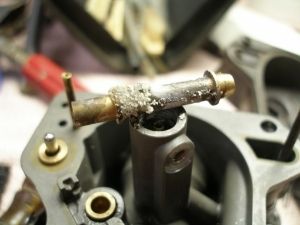After two days of trials on my "new to me" 2004 BF20, the next day the motor would not start. Spark was good. The plugs appeared wet, and my standard 2-stroke fix -- pull the plugs, blow them off, open throttle and pull it over to clear fuel -- did no good. No visible water in the oil.
I decided to clean the carburetor:

It needed it!
HOWEVER:
after two trips to the carb cleaning bench, it finally started last night on pull #2 with the FE system active, running until warm; however it would not run on idle at all without that. My assumption is that I have a clog in the idle pilot circuit. So...
1) Does anybody know the exact routing of the passages to the pilot screw? The output passage is easy to see - from the bottom of the needle cavity to the carb throat behind the throttle plate - but I don't see the supply drilling.
2) Can the carb body be dipped? Are there hidden O-rings still in the body that will be ruined? Is the grey color a paint that will be stripped or anodizing?
3) How much idle blowby normally comes out of the vent tube that extends to the intake silencer? I'm getting sharp puffs form the tube each time I turn the motor over.
I decided to clean the carburetor:

It needed it!
HOWEVER:
after two trips to the carb cleaning bench, it finally started last night on pull #2 with the FE system active, running until warm; however it would not run on idle at all without that. My assumption is that I have a clog in the idle pilot circuit. So...
1) Does anybody know the exact routing of the passages to the pilot screw? The output passage is easy to see - from the bottom of the needle cavity to the carb throat behind the throttle plate - but I don't see the supply drilling.
2) Can the carb body be dipped? Are there hidden O-rings still in the body that will be ruined? Is the grey color a paint that will be stripped or anodizing?
3) How much idle blowby normally comes out of the vent tube that extends to the intake silencer? I'm getting sharp puffs form the tube each time I turn the motor over.



















